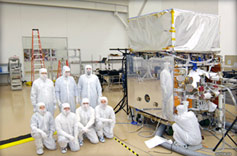
Handy Links
SLAC News Center
SLAC Today
- Subscribe
- Archives: Feb 2006-May 20, 2011
- Archives: May 23, 2011 and later
- Submit Feedback or Story Ideas
- About SLAC Today
SLAC News
Lab News
- Interactions
- Lightsources.org
- ILC NewsLine
- Int'l Science Grid This Week
- Fermilab Today
- Berkeley Lab News
- @brookhaven TODAY
- DOE Pulse
- CERN Courier
- DESY inForm
- US / LHC
SLAC Links
- Emergency
- Safety
- Policy Repository
- Site Entry Form

- Site Maps
- M & O Review
- Computing Status & Calendar
- SLAC Colloquium
- SLACspeak
- SLACspace
- SLAC Logo
- Café Menu
- Flea Market
- Web E-mail
- Marguerite Shuttle
- Discount Commuter Passes
-
Award Reporting Form
- SPIRES
- SciDoc
- Activity Groups
- Library
Stanford
Around the Bay
GLAST Satellite Lodging in Comfortable, "Clean Room"
 As the Gamma-Ray Large Area Telescope (GLAST)—which now includes the SLAC-built Large Area Telescope (LAT)—awaits its
December launch date, it's currently being checked and tested in a clean room at General Dynamics in Gilbert, Arizona.
As the Gamma-Ray Large Area Telescope (GLAST)—which now includes the SLAC-built Large Area Telescope (LAT)—awaits its
December launch date, it's currently being checked and tested in a clean room at General Dynamics in Gilbert, Arizona.
The clean room was designed to have low levels of environmental pollutants including aerosols, chemical vapors, dust, and airborne microscopic organisms. To accomplish this, the clean room filters air as it enters, and continually runs all room air through additional filters. In addition, members of the GLAST team wear protective bunny suits whenever they are inside the clean room. The suit prevents dirt and dust on clothing from entering the room.
"Working in these bunny suits is inconvenient, but necessary," said Steve Ritz, GLAST Project Scientist at NASA Goddard Space Flight Center. "With a million channels of electronics and high-tech sensitive instrumentation, we must avoid contamination. Although the cleanliness requirements for GLAST are relatively modest, an unwanted piece of every-day junk in the wrong place could cause a big headache later in the mission. Dust never sleeps."
Satellites like GLAST are assembled and checked in clean rooms because the instruments onboard are very sensitive to dust, and they can degrade when exposed to humidity. A clean room maintains a constant temperature and humidity, eliminates dust, and protects the satellite during its development, construction, and testing. Even the floor of a clean room is specially constructed so that static electricity—which can also harm instruments on satellites—cannot build up.
Once GLAST is launched from Florida and working in orbit, it will detect X-rays and gamma-rays in a range from thousands of times more energy to hundreds of billions of times more energy than the light visible to the human eye. Radiation of such power can only be generated under the most extreme conditions, such as in disks of gas swirling around black holes and neutron stars at near light speed. GLAST will therefore observe the most energetic objects in the universe. Scientists want to study these high-energy objects and events because they could give us a totally new understanding of our universe and reveal things we've never seen before. Some gamma rays travel as much as 10 billion light years through the universe to tell us their stories, but they scatter on the atmosphere and are lost. GLAST goes above the atmosphere to gather their information.
GLAST will be "moving out" of the clean room and onto the launch pad this winter.
NASA's GLAST mission is an astrophysics and particle physics partnership, developed in collaboration with the U.S. Department of Energy, along with important contributions from academic institutions and partners in France, Germany, Italy, Japan, Sweden, and the U.S.
More information is available from the GLAST website.
—Rob Gutro, SLAC Today, July 9, 2007
Above image: Technicians pose in the General Dynamics clean room. Pictured standing here are: Chip Meegan, NASA's Marshall Space Flight Center; Peter Michelson, Stanford University; Steve Ritz, NASA's Goddard Space Flight Center. Kneeling are: Bill Atwood, University of California at Santa Cruz; Dan Blackwood and Rick Harnden, both of NASA Headquarters; and Neil Johnson, Naval Research Laboratory. In the right corner, a technician checks the satellite. (Image courtesy of NASA and General Dynamics.)